| Listing 1 - 10 of 36 | << page >> |
Sort by
|
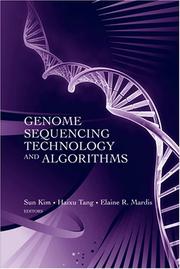
ISBN: 1596930950 9781596930957 1596930942 9781596930940 Year: 2008 Publisher: Boston : Artech House,
Abstract | Keywords | Export | Availability | Bookmark
 Loading...
Loading...Choose an application
- Reference Manager
- EndNote
- RefWorks (Direct export to RefWorks)
"From a who's who of pioneers in the field comes a unique resource covering the latest advances in next generation genome sequencing and assembly. This groundbreaking book includes non-conventional techniques that are paving the way to potential new biomedical applications. Practitioners find unparalleled access to state-of-the-art DNA sequencing technologies, new algorithmic sequence assembly techniques, and emerging methods for both resequencing and de novo genome analysis, which all together offer the most solid foundation possible for tackling the full range of experimental and computational challenges in the genome sciences today."--Jacket.
Genomes --- Nucleotide sequence. --- Analysis, Nucleic acid sequence --- Analysis, Nucleotide sequence --- Base sequence (Nucleic acids) --- DNA sequence --- Nucleic acid sequence analysis --- Nucleotide sequence analysis --- RNA sequence --- Sequence, Nucleotide --- Nucleic acids --- Nucleotides --- Sequence alignment (Bioinformatics) --- Genetics --- Genomics --- Haploidy --- Analysis. --- Analysis
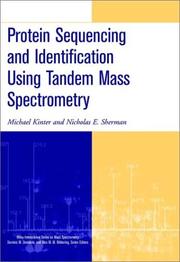
ISBN: 0471322490 Year: 2000 Publisher: New York (N.Y.) Wiley-Interscience
Abstract | Keywords | Export | Availability | Bookmark
 Loading...
Loading...Choose an application
- Reference Manager
- EndNote
- RefWorks (Direct export to RefWorks)
How to design, execute, and interpret experiments for protein sequencing using mass spectrometryThe rapid expansion of searchable protein and DNA databases in recent years has triggered an explosive growth in the application of mass spectrometry to protein sequencing. This timely and authoritative book provides professionals and scientists in biotechnology research with complete coverage of procedures for analyzing protein sequences by mass spectrometry, including step-by-step guidelines for sample preparation, analysis, and data interpretation.Michael Kinter and Nicholas Sherman present their own high-quality, laboratory-tested protocols for the analysis of a wide variety of samples, demonstrating how to carry out specific experiments and obtain fast, reliable results with a 99uccess rate. Readers will get sufficient experimental detail to apply in their own laboratories, learn about the proper selection and operation of instruments, and gain essential insight into the fundamental principles of mass spectrometry and protein sequencing. Coverage includes:* Peptide fragmentation and interpretation of product ion spectra* Basic polyacrylamide gel electrophoresis* Preparation of protein digests for sequencing experiments* Mass spectrometric analysis using capillary liquid chromatography* Techniques for protein identification by database searches* Characterization of modified peptides using tandem mass spectrometryAnd much more
Spectrometric and optical chemical analysis --- Organic spectroscopy --- Mass spectrometry. --- Nucleotide sequence. --- Proteins --- Analysis. --- Mass spectrometry --- Nucleotide sequence --- Analysis, Nucleic acid sequence --- Analysis, Nucleotide sequence --- Base sequence (Nucleic acids) --- DNA sequence --- Nucleic acid sequence analysis --- Nucleotide sequence analysis --- RNA sequence --- Sequence, Nucleotide --- Nucleic acids --- Nucleotides --- Sequence alignment (Bioinformatics) --- Mass spectra --- Mass spectrograph --- Mass spectroscopy --- Mass spectrum analysis --- Mass (Physics) --- Nuclear spectroscopy --- Spectrum analysis --- Analysis
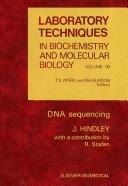
ISBN: 0444804978 9780080858791 0080858791 9780444804976 0444803858 9786611756383 1281756385 9780444803856 Year: 1983 Volume: 10 Publisher: Amsterdam New York New York, N.Y.
Abstract | Keywords | Export | Availability | Bookmark
 Loading...
Loading...Choose an application
- Reference Manager
- EndNote
- RefWorks (Direct export to RefWorks)
This volume provides a comprehensive description of the principles and methods used in DNA sequencing. Following a detailed introduction the chapters are: DNA sequencing; Chain terminator sequencing; Primed synthesis methods applied to DNA fragments cloned into phage M13; DNA sequencing by the Maxam-Gilbert chemical procedure; Computer methods for DNA sequencers; Appendices including contractions and special terms, cloning vectors, commercially available restriction endonucleases, and autoradiography.
Analytical biochemistry --- Molecular biology --- Dna --- Nucleotide sequence. --- Base sequence. --- Dna. --- Analysis. --- DNA --- Nucleotide sequence --- Analysis, Nucleic acid sequence --- Analysis, Nucleotide sequence --- Base sequence (Nucleic acids) --- DNA sequence --- Nucleic acid sequence analysis --- Nucleotide sequence analysis --- RNA sequence --- Sequence, Nucleotide --- Nucleic acids --- Nucleotides --- Sequence alignment (Bioinformatics) --- Analysis
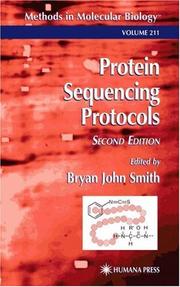
ISBN: 0896039757 9786610842254 1280842253 1592593429 9780896039759 Year: 2003 Volume: 211 Publisher: Totowa, NJ : Humana Press : Imprint: Humana,
Abstract | Keywords | Export | Availability | Bookmark
 Loading...
Loading...Choose an application
- Reference Manager
- EndNote
- RefWorks (Direct export to RefWorks)
Bryan John Smith updates his much-acclaimed first edition of Protein Sequencing Protocols with new and refreshed techniques for determining the sequence of proteins and peptides. This edition includes not only novel approaches to the validation of quality assurance methods, reflecting the current importance of biopharmaceuticals, but also offers a guide to the analysis of protein sequence information via the powerful new tools of bioinformatics. Each readily reproducible protocol contains detailed step-by-step instructions to ensure successful experimental results, along with notes on troubleshooting and how to avoid pitfalls. Valuable appendices summarize changes in mass arising from protein modification, as well as consensus sequences for protein modification. Comprehensive and up-to-date, Protein Sequencing Protocols, Second Edition, provides both novice and expert investigators alike a ready source of easy-to-follow protocols that simplify choosing the most appropriate method for protein sequence determination and thus help assure robust results.
Nucleotide sequence --- Nucleotides --- Analysis. --- Analysis, Nucleic acid sequence --- Analysis, Nucleotide sequence --- Base sequence (Nucleic acids) --- DNA sequence --- Nucleic acid sequence analysis --- Nucleotide sequence analysis --- RNA sequence --- Sequence, Nucleotide --- Nucleic acids --- Sequence alignment (Bioinformatics) --- Analysis --- Biochemistry. --- Biochemistry, general. --- Biological chemistry --- Chemical composition of organisms --- Organisms --- Physiological chemistry --- Biology --- Chemistry --- Medical sciences --- Composition
Book
ISBN: 0128018410 0128017392 9780128018415 9780128017395 Year: 2016 Publisher: London
Abstract | Keywords | Export | Availability | Bookmark
 Loading...
Loading...Choose an application
- Reference Manager
- EndNote
- RefWorks (Direct export to RefWorks)
Nucleotide sequence. --- Medical genetics. --- Clinical genetics --- Diseases --- Heredity of disease --- Human genetics --- Medical sciences --- Pathology --- Genetic disorders --- Analysis, Nucleic acid sequence --- Analysis, Nucleotide sequence --- Base sequence (Nucleic acids) --- DNA sequence --- Nucleic acid sequence analysis --- Nucleotide sequence analysis --- RNA sequence --- Sequence, Nucleotide --- Nucleic acids --- Nucleotides --- Sequence alignment (Bioinformatics) --- Genetic aspects --- Analysis
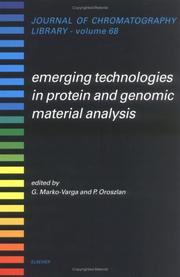
ISBN: 1281055018 9786611055011 0080530842 044450964X 9780080530840 9780444509642 Year: 2003 Publisher: Amsterdam ; Boston : Elsevier,
Abstract | Keywords | Export | Availability | Bookmark
 Loading...
Loading...Choose an application
- Reference Manager
- EndNote
- RefWorks (Direct export to RefWorks)
It is widely recognized that analytical technologies and techniques are playing a pioneering role in a range of today's foremost challenging scientific endeavours, including especially biological and biomedical research. Worthy of mention, for example, are the role that high performance separation techniques played in mapping the human genome and the pioneering work done within mass spectrometry. It is also apparent that state-of-the-art pharmaceutical and biomedical research is the major driving force of the development of new analytical techniques. Advancements in genomics research h
Proteins --- Nucleotide sequence. --- Chromatographic analysis. --- Mass spectrometry. --- Analysis. --- Mass spectra --- Mass spectrograph --- Mass spectroscopy --- Mass spectrum analysis --- Analysis, Chromatographic --- Chromatography --- Analysis, Nucleic acid sequence --- Analysis, Nucleotide sequence --- Base sequence (Nucleic acids) --- DNA sequence --- Nucleic acid sequence analysis --- Nucleotide sequence analysis --- RNA sequence --- Sequence, Nucleotide --- Mass (Physics) --- Nuclear spectroscopy --- Spectrum analysis --- Chemistry, Analytic --- Phase partition --- Nucleic acids --- Nucleotides --- Sequence alignment (Bioinformatics) --- Analysis --- Analytical chemistry
Book
ISBN: 1789842026 1789842018 1838816712 Year: 2018 Publisher: IntechOpen
Abstract | Keywords | Export | Availability | Bookmark
 Loading...
Loading...Choose an application
- Reference Manager
- EndNote
- RefWorks (Direct export to RefWorks)
Polymorphism or variation in DNA sequence can affect individual phenotypes such as color of skin or eyes, susceptibility to diseases, and response to drugs, vaccines, chemicals, and pathogens. Especially, the interfaces between genetics, disease susceptibility, and pharmacogenomics have recently been the subject of intense research activity. This book is a self-contained collection of valuable scholarly papers related to genetic diversity and disease susceptibility, pharmacogenomics, ongoing advances in technology, and analytic methods in this field. The book contains nine chapters that cover the three main topics of genetic polymorphism, genetic diversity, and disease susceptibility and pharmacogenomics. Hence, this book is particularly useful to academics, scientists, physicians, pharmacists, practicing researchers, and postgraduate students whose work relates to genetic polymorphisms.
Disease susceptibility --- Nucleotide sequence. --- Genetics. --- Genetic aspects. --- Biology --- Embryology --- Mendel's law --- Adaptation (Biology) --- Breeding --- Chromosomes --- Heredity --- Mutation (Biology) --- Variation (Biology) --- Analysis, Nucleic acid sequence --- Analysis, Nucleotide sequence --- Base sequence (Nucleic acids) --- DNA sequence --- Nucleic acid sequence analysis --- Nucleotide sequence analysis --- RNA sequence --- Sequence, Nucleotide --- Nucleic acids --- Nucleotides --- Sequence alignment (Bioinformatics) --- Medical genetics --- Analysis --- Life Sciences --- Human Genetics --- Genetics and Molecular Biology --- Biochemistry
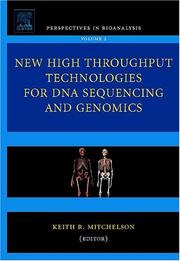
ISBN: 1280962682 9786610962686 0080471285 0444522239 9780444522238 9780080471280 Year: 2007 Publisher: Amsterdam Boston
Abstract | Keywords | Export | Availability | Bookmark
 Loading...
Loading...Choose an application
- Reference Manager
- EndNote
- RefWorks (Direct export to RefWorks)
Since the independent invention of DNA sequencing by Sanger and by Gilbert 30 years ago, it has grown from a small scale technique capable of reading several kilobase-pair of sequence per day into today's multibillion dollar industry. This growth has spurred the development of new sequencing technologies that do not involve either electrophoresis or Sanger sequencing chemistries. Sequencing by Synthesis (SBS) involves multiple parallel micro-sequencing addition events occurring on a surface, where data from each round is detected by imaging. New High Throughput Technologies for DNA Se
Nucleotide sequence --- Genomics --- Genetic engineering --- Technological innovations. --- Designed genetic change --- Engineering, Genetic --- Gene splicing --- Genetic intervention --- Genetic surgery --- Genetic recombination --- Biotechnology --- Transgenic organisms --- Genome research --- Genomes --- Molecular genetics --- Analysis, Nucleic acid sequence --- Analysis, Nucleotide sequence --- Base sequence (Nucleic acids) --- DNA sequence --- Nucleic acid sequence analysis --- Nucleotide sequence analysis --- RNA sequence --- Sequence, Nucleotide --- Nucleic acids --- Nucleotides --- Sequence alignment (Bioinformatics) --- Research --- Analysis
Book
ISBN: 9781936113873 1936113872 Year: 2013 Publisher: New York Cold Spring Harbor laboratory press
Abstract | Keywords | Export | Availability | Bookmark
 Loading...
Loading...Choose an application
- Reference Manager
- EndNote
- RefWorks (Direct export to RefWorks)
Nucleotide sequence. --- Bioinformatics. --- Bioinformatics --- Nucleotide sequence --- Analysis, Nucleic acid sequence --- Analysis, Nucleotide sequence --- Base sequence (Nucleic acids) --- DNA sequence --- Nucleic acid sequence analysis --- Nucleotide sequence analysis --- RNA sequence --- Sequence, Nucleotide --- Bio-informatics --- Biological informatics --- Nucleic acids --- Nucleotides --- Sequence alignment (Bioinformatics) --- Biology --- Information science --- Computational biology --- Systems biology --- Analysis --- Data processing
Book
ISBN: 0128205199 0128205202 9780128205204 9780128205198 Year: 2021 Publisher: London : Academic Press,
Abstract | Keywords | Export | Availability | Bookmark
 Loading...
Loading...Choose an application
- Reference Manager
- EndNote
- RefWorks (Direct export to RefWorks)
Human genetics --- DNA --- Nucleotide sequence. --- Genetic disorders. --- Variation. --- Analysis. --- Diseases --- Medical genetics --- Congenital diseases --- Disorders, Genetic --- Disorders, Inherited --- Genetic diseases --- Hereditary diseases --- Inherited diseases --- Nucleic acids --- Nucleotides --- Sequence alignment (Bioinformatics) --- Analysis, Nucleic acid sequence --- Analysis, Nucleotide sequence --- Base sequence (Nucleic acids) --- DNA sequence --- Nucleic acid sequence analysis --- Nucleotide sequence analysis --- RNA sequence --- Sequence, Nucleotide --- Variation (Biology) --- Genetic variation in humans --- Analysis
| Listing 1 - 10 of 36 | << page >> |
Sort by
|

 Search
Search Feedback
Feedback About UniCat
About UniCat  Help
Help News
News